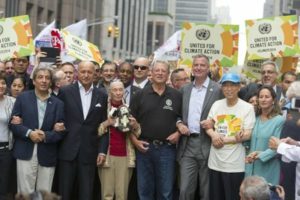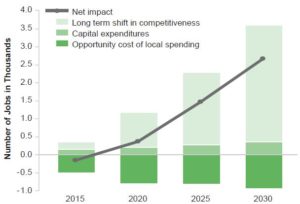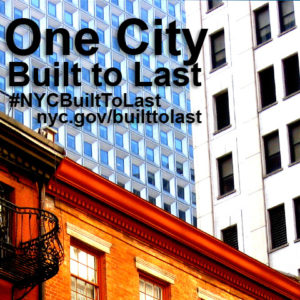In 2014 New York City officially recognized climate change as an “ an existential threat to New York City and humanity,” adopting a sweeping 10 year plan “One City: Built to Last” to reduce citywide carbon emissions by eighty percent by 2050. This policy includes pursuit of net-zero energy standards and updating all city buildings with efficiency systems and renewable power capacity.
- Category
- Energy
- Subcategory
- Passive House
- Adopted By
- City of New York, NY
- Applies To
- Existing and New Buildings in New York City
- Owned By
- Mayor's Office of Sustainability
- Managed By
- Department of Buildings
- Participation
- Year of Adoption
- 2014
- Current Version
- Update Cycle
- Recent Action
- Mayor's Announcement on 4/22/14
- Code/Policy
Responding to the United Nations call for developed countries to reduce greenhouse gas emissions 80% by the year 2050, New York City adopted the 10-year plan, which includes a suite of energy efficiency initiatives designed to dramatically reduce greenhouse gas emissions from the City’s over one million buildings. To inform their strategic approach, the City has conducted the most comprehensive analysis of New York City building energy-use data to-date. Key strategies include:
- Upgrading City buildings and piloting innovative technologies to lead by example
- Changing the Energy Code to raise standards for new construction and major alterations
- Expanding energy benchmarking to include mid-sized buildings
- Creating a data-driven “retrofit accelerator” to provide technical assistance to building owners
- Launching an Exemplary Buildings competition with incentives for very-low energy buildings
- Training and economic development to create 3500 jobs
The One City: Built to Last plan was at least in part inspired and informed by the success story of Brussels Belgium (see related case study) which followed a similarly comprehensive approach to dramatically reduce energy use and carbon emissions from both new and existing buildings.
| Policy Title | Purpose of Policy |
|---|---|
| OneCity Built to Last: Transforming New York City’s Buildings for A Low-Carbon Future | Retrofit public and private buildings to dramatically reduce the city’s contributions to climate change, while spurring major cost savings and creating thousands of new jobs. This makes New York the largest city to commit to reduce greenhouse gas emissions 80 percent reduction by 2050, and charts a long-term path for investment in renewable sources of energy and a total transition from fossil fuels. |
Since the plan was adopted, a combination of analysis, planning and legislative work was undertaken to move the city rapidly toward a performance-based paradigm for building energy regulation. At the same time, the City was leading by example, upgrading approximately 180 city-owned buildings per year, and adding solar to schools and other city-owned buildings.
In 2016, the City adopted the 2016 NY State Energy Conservation Code with local amendments including a new requirements for air tightness testing of all buildings between 25,000 and 50,000 square feet; and for testing or inspecting air barrier joints and seams in buildings over 50,000 square feet.
They city published a Technical Working Group report with results of a comprehensive analysis of building energy use data, that provided stakeholder input on strategic direction. They expanded their existing energy benchmarking program (requiring energy use disclosure from buildings 50,000 sf and larger, pursuant to Local Laws 84 and 87 of 2009) to include 16,800 additional mid-sized buildings between 25,000 and 50,000 sf.
-

Mayor Bill DeBlasio with Al Gore, Jane Goodall, UN Secretary General Ban Ki-Moon and other dignitaries at People’s Climate March Sept. 2014. Credit: UN Photo/Mark Garten The One City: Built to Last plan builds on an executive order to reduce greenhouse gas emissions from City owned buildings and operations by 30 percent over ten years. In 2006, they established an Office of Long-term Planning and Sustainability as a bureau within the mayor’s office, and in 2007 created a citizen board of 16 industry and environmental leaders of large organizations, tasked with: “benchmarking of energy consumption for all City buildings … assessing and prioritizing the use of energy-saving technologies; establishing … measuring and verifying protocols to monitor progress and energy savings; establishing accountability and enforcement policies for agencies, and staffing or other organizational recommendations required.” $80 million was dedicated to achieve these goals. To generate initial momentum, NYC government adopted a progressive leadership role to demonstrate emissions reduction strategies to others.
These measures led to the development of the One city Built to Last Plan.
Additional legislative moves included requiring large buildings over 25,000 sq/ft to benchmark their energy usage and update lighting and plumbing systems for energy efficiency. Seen as low hanging fruit for the PlaNYC goals, the proposals were adopted and provide incremental gains towards the eighty percent reduction by 2050 (80×50) goal.
The TWG report acknowledges that to meet the City’s 80 x 50 commitment will require all buildings to be part of the solution, including small, mid-sized, and historic buildings. Small and mid-sized buildings that are less than 50,000 square feet in floor area account for 98 percent of New York City’s building stock, but many residents of these buildings currently lack access to information about their building’s energy use. There are roughly 15,000 buildings (10,000 properties) that are between 25,000 to 50,000 square feet in floor area, which include 275,000 residential units and more than 365 million square feet of space. NYC has more than 33,000 landmarked properties, located in 114 historic districts and 20 historic district extensions across all five boroughs. All together, these buildings represent 11 percent of the city’s built square footage. Tenant energy use will also be addressed, particularly in commercial buildings where the energy used in commercial leased spaces can account for 40 to 60 percent of energy use or more of whole building energy use.
Adopted 2016 energy code requirements include require air-leakage testing for new buildings, to help prevent energy losses. For residential construction, exterior walls will be required to conform to more stringent climate zone specifications for better insulated homes and low-rise residential buildings. Require a solar-ready zone on roofs of one- and two-family homes that have sufficient solar potential.
-
- Require and Catalyze Retrofits in Existing Buildings
- Require buildings to complete cost-effective energy conservation measures.
- Require large and mid-size building owners to repair and improve heating distribution systems within the next 10 years, specifically focusing on steam systems and radiators.
- Require large and mid-size building owners to assess deep energy retrofit strategies as part of their required energy audit, through a simple template developed by the City.
- Improve efficiency and information transparency in mid-sized buildings and non-residential spaces.
Seek changes to historic building and other laws to encourage energy improvements.
By the adoption of the policy in 2014, NYC was conducting comprehensive analyses of building energy use data, and convened on a Buildings Technical Working Group (TWG) with more than 50 leaders from New York City’s real estate, engineering, architecture, labor, affordable housing, academic, and advocacy sectors. Over the course of a year the TWG provided input on strategies to put buildings on the pathway to 80 x 50, highlighting the need for certainty in budget and planning cycles of building developers.
In 2015, the City established the NYC Energy Code Advisory committee to develop, review and recommend changes to the energy code. Months of dedicated efforts by Gina Bocra (NYC Chief Sustainability Officer) and the team at Department of Buildings, working closely with Urban Green, AIANY and other stakeholders to shepherd the NYCECC from inception to law, including several key NYC-specific provisions that move beyond the legally required state energy code.
| Buildings Technical Working Group Report, Mayor’s Office of Sustainability, April 22, 2016. | Working Group report Highilights article by Urban Green Council. |
| Article on the Plan “Mayor de Blasio Commits to 80 Percent Reduction of Greenhouse Gas Emissions by 2050, Starting with Sweeping Green Buildings Plan,” City of New York, 9/21/14 | Greener, Greater Buildings Plan website |
| 2016 New York City Energy Conservation Code | NYC Retrofit Accelerator Webpage |
| Local Law 84: Benchmarking: annual requirement to benchmark building energy and water consumption | Local Law 87: Energy Audits & Retro-commissioning: complete an energy audit and perform retro-commissioning once every 10 years |
The TWG report describes a growing consensus that the current approach of incremental improvements to prescriptive code requirements is reaching the limits of its effectiveness to achieve greater energy savings and GHG reductions. Analysis shows that placing increasingly stringent requirements on disparate components and systems without considering the holistic building energy performance will not achieve the scale of reductions needed to prepare buildings for 80 x 50. The report recommends that future revisions to codes “encourage developers to maximize the efficiencies of all systems and address how building systems interact to avoid missed opportunities for reducing energy use.” Requiring new building and substantial renovations to be designed to meet an energy performance target represents a major shift in how buildings are typically designed and constructed today.
To achieve the full potential of GHG reductions, the City will work to remove barriers and expand opportunities to implementing energy efficiency measures. Buildings in new sectors, sizes, and use categories will need to contribute to the City’s energy reduction goals. Professionals and trades alike will be trained in new methods and technologies. Increased coordination between landlords and tenants on energy efficiency must become standard practice. Investments in energy efficiency will yield operational cost-savings that will lower housing costs for New Yorkers, but the City must work to bring down the upfront costs and help building owners undertake these investments through new and existing financing options.
 To help building owners and managers comply with these new requirements, the City will offer a variety of supporting programs, including the following:
To help building owners and managers comply with these new requirements, the City will offer a variety of supporting programs, including the following:
- NYC Retrofit Accelerator, providing a free one-stop shop to help building owners and operators complete energy and water upgrades.
- NYC Benchmarking Help Center, with CUNY’s Building Performance Lab, provides free technical assistance and support for all covered buildings
- The NYC Energy & Water Performance Map allows New Yorkers to understand the energy and waste efficiency of more than 26,000 buildings across the city, mapping benchmarking data
- The Green Housing Preservation Program, launched in May 2015, provides no- and low-cost financing for efficiency and conservation improvements, along with moderate rehab work, for small- to mid-sized multifamily buildings. Coming Soon: High Performance Retrofit Track, which will focus on assisting building owners in achieving deep energy reductions of 40 to 60 percent.
- Exemplary Buildings Program: To develop additional proof of concept and allow the industry time for experimentation, the City will launch a large-scale competition for the design and construction of very low-energy buildings, which will include incentives, education, training, and marketing for competition participants. An industry-wide program will accelerate the growth in the knowledge base for energy performance design and construction to help spur the transition to a new era of world-class low-energy buildings. The program will also provide market support to help reduce the costs of related products and services and will develop proof of concept details across a broad range of building types.
- Staff Training: A practical, tailored energy efficiency training for building staff to advance their professional capacity and improve building operations in small and mid-sized buildings.
- NYC Carbon Challenge for Commercial Offices will be expanded to invite New York City’s major landlords to meet voluntary carbon reduction targets.
The City will build upon the work of the Buildings Technical Working Group to develop similar requirements for the waste, transportation, and energy supply sectors, as part of a comprehensive 80×50 Implementation Plan: NYC Clean Fleet, Zero Waste, and a major expansion of solar on public and private buildings.

The plan will create a thriving, self-sustaining market for energy efficiency upgrades and renewable energy generation, by removing market barriers, providing information and assistance to reach the widest possible audience, focusing on affordable housing, and helping position the local workforce to tap into the jobs and economic opportunities that will result from this growing market.
A 2013 report indicated a 19 percent reduction in emissions from the 2005 levels, and the best air quality in 50 years. The retrofit accelerator claims to be working with about 4,000 buildings across NYC to achieve the goals. According to the report: “Achieving 80 by 50 is theoretically feasible but would require change at an unprecedented and technologically-untested scale. […] Up to two thirds of these investments could be cost effective because they would yield energy savings that would offset upfront costs; the rest would yield little or no payback. Regardless of the economics, market barriers would need to be overcome at every step of the way.” Additionally, while the Accelerator has begun work on 4,000 buildings, NYC contains more than one million structures, only a fraction of which have opted in over the last 2 years.
A new performance-based paradigm. Moving forward, the City will also seek to change the paradigm for future Energy Code updates to ensure that they account for whole building energy performance and the interaction of systems. The City will require that new buildings are evaluated according to a performance-based metric in 2019, and require energy design targets beginning in 2022. This will ensure GHG reductions in new buildings are being met, while spurring innovation in efficient design.
A new performance-based paradigm. Moving forward, the City will also seek to change the paradigm for future Energy Code updates to ensure that they account for whole building energy performance and the interaction of systems. The City will require that new buildings are evaluated according to a performance-based metric in 2019, and require energy design targets beginning in 2022. This will ensure GHG reductions in new buildings are being met, while spurring innovation in efficient design.
Mayor
Commissioner of Buildings
Chief Sustainability Officer
